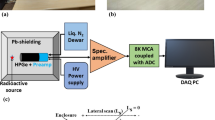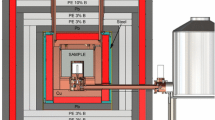Abstract
Physics experiments, environmental surveillance, and treaty verification techniques continue to require increased sensitivity for detecting and quantifying radionuclides of interest. This can be done by detecting a greater fraction of gamma emissions from a sample (higher detection efficiency) and reducing instrument backgrounds. A current effort for increased sensitivity in high resolution gamma spectroscopy will produce an intrinsic germanium (HPGe) array designed for high detection efficiency, ultra-low-background performance, and useful coincidence efficiencies. The system design is optimized to accommodate filter paper samples, e.g. samples collected by the Radionuclide Aerosol Sampler/Analyzer (RASA). The system will provide high sensitivity for weak collections on atmospheric filter samples, as well as offering the potential to gather additional information from more active filters using gamma cascade coincidence detection. The current effort is constructing an ultra-low-background HPGe crystal array consisting of two vacuum cryostats, each housing a hexagonal array of 7 crystals on the order of 70% relative efficiency per crystal. Traditional methods for constructing ultra-low-background detectors are used, including use of materials known to be low in radioactive contaminants, use of ultra pure reagents, clean room assembly, etc. The cryostat will be constructed mainly from copper electroformed into near-final geometry at PNNL. Details of the detector design, simulation of efficiency and coincidence performance, HPGe crystal testing, and progress on cryostat construction are presented.







Similar content being viewed by others
References
Aalseth CE, Hossbach TW, Miley HS (2004) In: IEEE nuclear science symposium conference record, vol 2, p 1937
Kazkaz K, Aalseth CE, Hossbach TW, Gehman VM, Kephart JD, Miley HS (2003) In: IEEE nuclear science symposium conference record, 2004, vol 1, p 87
Orrell JL, Aalseth CE, Amsbaugh JF, Doe PJ, Hossbach TW (2007) Nucl Instrum Methods A 579(1):91
Agostinelli S et al (2003) Nucl Instrum Methods A 506:250
Allison J et al (2006) IEEE Trans Nucl Sci 53:270
Warren GA, Smith LE, Aalseth CE, Ellis JE, Valsan AB, Mengesha W (2006) IEEE Trans Nucl Sci 53:351
Perkins RW, Jenquin UP (1997) Pacific Northwest National Laboratory Document PNNL-11554
Warren GA, Smith LE, Aalseth CE, Ellis JE, Valsan AB, Mengesha W (2006) IEEE Trans Nucl Sci 53:351
Brodzinski RL, Miley HS, Reeves HJ, Avignone FTIII (1990) Nucl Instrum Methods A 292(2):337
Aalseth CE, Farmer OT, Fast JE, Hoppe EW, Hossbach TW, Kephart JD, Litke KE, Liezers M, Miley HS, Mintzer EE, Reeves JS (2009) Nucl Instrum Methods A (submitted)
Acknowledgements
We would like to thank the DOE and the NEM program for sponsorship of this work; U. S. Department of Energy, Office of Nonproliferation and National Security, Office of Research and Development. Contract No. DE-AC06-76RLO 1830.
Author information
Authors and Affiliations
Corresponding author
Rights and permissions
About this article
Cite this article
Keillor, M.E., Aalseth, C.E., Day, A.R. et al. Design and construction of an ultra-low-background 14-crystal germanium array for high efficiency and coincidence measurements. J Radioanal Nucl Chem 282, 703–708 (2009). https://doi.org/10.1007/s10967-009-0248-7
Received:
Accepted:
Published:
Issue Date:
DOI: https://doi.org/10.1007/s10967-009-0248-7




